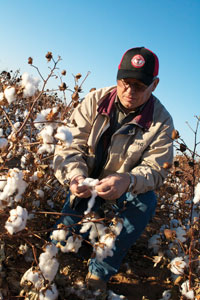
Changing the Industry
Story and Photo by Nickelynn Bays
Wildfires have blazed, lakes have dried, and crops have simply disintegrated. The worst drought to occur in Texas has taken a toll on the state, and there has yet to be any significant rainfall. Unfortunately, according to the National Weather Service, there is little to suggest any end to the drought that has plagued the state since fall 2010.
Along with drought-related worries, farmers are now faced with the discontinuation of a popular pesticide, commercially sold as Temik. According to the Environmental Protection Agency, Temik no longer meets food safety standards; recent studies show there are risks of ingesting the chemical through groundwater or the food supply.
To adapt to the devastatingly dry conditions and pesticide restrictions, researchers at the USDA-Agricultural Research Services, in Lubbock, Texas, are diligently working to find alternative farming practices.
Out of all the experiments the USDA-ARS has conducted, the most substantial is the cytokinin enhancement of cotton. This idea was developed by John Burke, Ph.D., the lab director and research leader at the USDA-ARS in Lubbock. The Lubbock location is the first and only lab in the nation conducting this experiment with cotton. The project was patented in 2009 and is now available for commercial licensing.
“It sends a signal to the plant,” Burke said, “that kicks in the plant’s natural defense mechanisms which can cause the plant to produce more cuticular wax to prevent water loss and expand the plant’s root system to have access to more available water.”
Burke found cytokinins promote cell division and growth in plants. In cotton, cytokinins stimulate the growth of the main plant stem and branches. Research has found applying the hormone cytokinin to cotton seed, or to a growing cotton plant, will increase the rate of development in fruiting branches, decrease the time to first bloom, increase the number of cotton squares formed, reduce water usage, and increase root development.
DeeDee Laumbach, laboratory technician for the USDA-ARS, is working with Burke to further develop the cytokinin enhancement of cotton, while also working on numerous other projects for the USDA-ARS.
“I really love what I do,” Laumbach said, “and I take a lot of pride in what we have accomplished.”
Laumbach and other researchers have worked diligently to further examine the effects of cytokinin. In their studies, they found this hormone can also prevent nematodes from destroying crops. When cytokinin is introduced to cotton plants, root systems develop allowing the plant to survive despite nematode’s efforts to destroy the crop.
Kent Wood, the cropping farm manager at the USDA-ARS, said the results were astonishing. He said he knew cytokinins were able to improve cotton plants in multiple ways, but never thought they would also find a solution to the nematode issues. Wood said the theory is simple and is surprised no one had thought of it before.
“The cytokinin application allows the plant to produce more roots,” Wood said, “this allows the plant to withstand the damages of nematodes.”
Burke said nematodes will be less likely to permanently damage a growing cotton plant since the plant has a higher survival rate because of the plant’s above average root system. He said this was something that did not necessarily occur to him at first, but as the discontinuation of Temik became more prevalent, he knew they had found a solution.
Laumbach said the introduction of the hormone cytokinin is essentially the solution to multiple issues the cotton industry is facing. She said future endeavors include research to evaluate the effects of cytokinin on other commodities, such as corn and sorghum, as well.
“Cytokinin applications are much safer for the environment than Temik,” Laumbach said, “and can eliminate costs for farmers since they’ll have to apply fewer pesticide treatments depending on the region.”
In some areas, nematodes are the only insects of concern. Therefore, the application of cytokinin to cotton seeds prior to purchase will eliminate future costs of a pesticide treatment.
“We’ve found that if we apply just one treatment of cytokinin, we can get yield increases in dry land conditions between five to 20 percent,” Burke said.
Additionally, tests determined that cytokinins did not hinder yields under fully irrigated or rainy conditions, making it safe for use in all weather environments. There is also no extra work involved for the grower because cytokinins can be applied when conducting normal weed-management practices early in the season.
The USDA-ARS is working closely with commercial companies to manufacture a product accessible to cotton farmers in the near future.
“I really think if there’s a product that could change the industry forever, it will be this one.” Laumbach said.